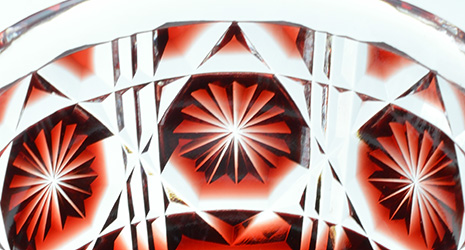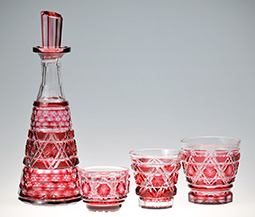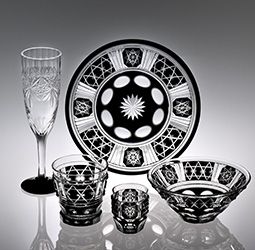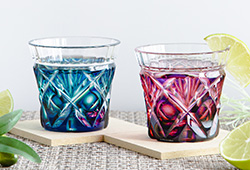November 2022
- English
- 日本語
The Revival and Development of Satsuma Kiriko

Close-up of a small sake cup showing the bokashi (color gradation) that characterizes Satsuma Kiriko 
Cutting Satsuma Kiriko glass on a wheel

Satsuma Kiriko decanter and glasses 
Black tableware with beautiful ink painting-like gradation 
Glasses in the “Nishiki-e” series featuring new designs

Satsuma Kiriko, an example of kiriko cut glass, is characterized by its gradations of deep color and intricate cutting. First produced by the Satsuma Clan (in present-day Kagoshima Prefecture) in the second half of the nineteenth century, manufacturing of the glass ceased for some 110 years before it was revived in the 1980s and is now once again attracting attention.

Satsuma Kiriko fascinates people with its beautiful colors and a sparkle created by intricate cutting.
Satsuma Kiriko’s charm is chiefly characterized by its color gradations, called bokashi. These are created by cutting patterns into iro-kise glass, which is thick colored glass that has been overlaid onto clear glass, a design unique to Satsuma Kiriko. Decorative patterns are created by making diagonal incisions into the glass, and because the glass is thick, subtle color shading can be achieved depending on the depth and angle of the incisions. It is these gradations of color that lend Satsuma Kiriko its warm yet delicate appearance.
Satsuma Kiriko was first produced by the Satsuma Clan in the second half of the 19th century, but for a short period of only about 20 years. Production ceased for some 110 years before the craft was revived in the 1980s.
Arima Hitoshi, sales manager of Satsuma Kiriko manufacturer Shimadzu Limited, explains, “Satsuma Kiriko was first made in 1851 as an artistic craft aimed at overseas markets under the direction of the feudal Satsuma Clan. Thickly layering colored glass on clear glass and engraving intricate patterns is expensive and time-consuming. It is not something that can be done easily by an individual. Satsuma Kiriko was a luxury craft product made with support from the Satsuma Clan.”

However, when the feudal lord who encouraged the production of kiriko died, manufacturing was scaled down, and as the factories disappeared due to the disturbances of war at the end of the Tokugawa shogunate, by the early Meiji period production ceased entirely.
In 1982, an expert researching the history of glass exhibited Satsuma Kiriko, which he himself had reproduced, at a department store in Kagoshima. This sparked a growing desire to revitalize Satsuma Kiriko, and in 1985, Shimadzu Limited took the helm of the project to revive the product.

Referencing the few materials and old photographs that existed, the company worked hard to find the ideal colors and cutting angles to express the bokashi that is characteristic of Satsuma Kiriko. As a result of a process of repeated trial and error, the company was able to reproduce the glassware, and Satsuma Kiriko is now once again widely appreciated. Moreover, new types of Satsuma Kiriko are being manufactured in addition to the faithful reproductions. One of them is the “Nishiki-e” (brocade picture) series, in which transparent glass is overlaid with two different colors of glass. There is, for example, glassware whose colors shift from deep red to ultramarine like the colors of the Kagoshima sky changing from sunset to approaching darkness, and glassware with colors capturing various aspects of Kagoshima’s natural beauty.
Arima says, “We want Satsuma Kiriko to be not only a traditional craft, but also a craft that passes on its DNA to the next generation. The techniques and characteristics of Satsuma Kiriko won’t change, but we’re not afraid to bring in new ideas. We will make it a craft that continues to evolve.”

This entrepreneurial trait of taking on new challenges is the proud spirit of Satsuma’s people*. It will be fascinating to see how Satsuma Kiriko evolves in the future.
* Satsuma is the old name for what is now Kagoshima Prefecture, and even today, Kagoshima Prefecture is often referred to as such.

